There are three functions of automatic transmission fluid (ATF), and the transmission cooling system plays a role in each of them.
- Hydraulically move valves and apply holding elements.
- Lubricates moving parts in the transmission.
- Regulates transmission temperature.
It’s all about Clean Fluid and Flow!!!
During the installation of newly remanufactured transmissions, contamination from an improperly serviced transmission cooling system may cause small passages to plug or valves to stick.
With clearances of .0015” in the valve body bore, it is very important to have clean transmission fluid circulating. Debris as small as a single human hair may cause a transmission to fail. For this reason, we certify our transmissions are clean prior to shipping them. Our dyno testing processes monitor for debris as small as 10 microns (.0003”).
Types of coolers / exchangers
Internal to the Radiator is the most common. There is a core connected to the transmission cooler lines that circulate ATF in the engine radiator tank. The core is submerged in engine coolant and is sealed to separate the two fluids. Due to the physics of heat transfer, the core can transfer the heat in the ATF to the engine coolant in the radiator. This is a fluid-to-fluid type of heat transfer.
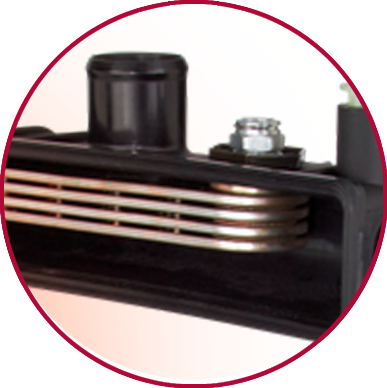
Internal Cooler
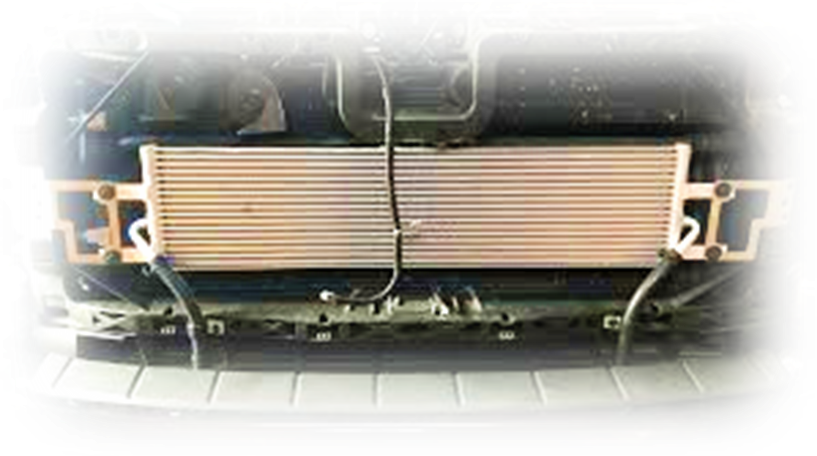
External Cooler
Externally mounted is a core with only one inlet and one outlet for transmission fluid to circulate. Heat transfer occurs through fins connected between the fluid passages. The fins are exposed to airflow that dissipates the heat. This is a fluid-to-air type of cooler. This style of cooler may also be used in series with the radiator cooler in heavy-duty applications.
Shared cooler core with the AC condenser. This type has an inlet and outlet for AC refrigerant lines and an inlet and outlet for transmission fluid. The fluids are separated from each other, but they are contained in the same frame and space. When replacing this style of cooler, you will need to evacuate the Air Conditioning system. This is a fluid-to-air type of cooler.
ATF Warmer has an inlet and outlet for engine coolant and an inlet and outlet for transmission fluid. This is similar to the internal radiator construction but, the cooler is bolted to the transmission case instead. These are fluid-to-fluid types of coolers.
This warmer has a mating surface with O-rings to seal against the transmission mating surface and circulate ATF. It has two tubes for the engine coolant hoses to connect.
This style warmer has a tube for each engine coolant hose as well as the transmission lines. This configuration will have external lines connecting to the transmission.
Internal cooler construction
- Early cooler design (pre-1990’s)
- Inefficient.
- Open tubes and passages.
- Does not have disruptors, turbulators, or obstacles to increase dwell time.
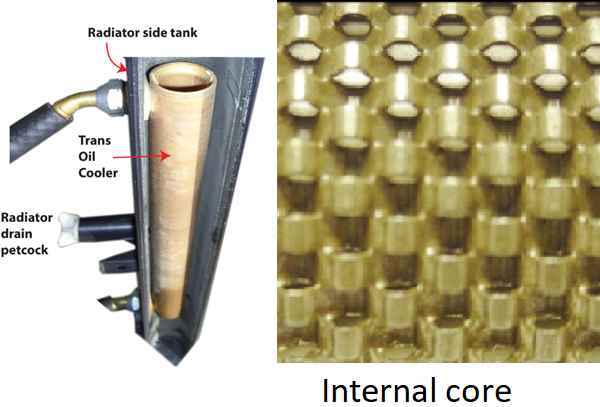
Internal Cooler Cross Section - Early Design
- Late Cooler Design - Stacked Plates starting in early 90’s
- Compact.
- Efficient.
- Plates have internal fins and baffles to increase the surface area for the transfer of heat.
- Increased fluid dwell time to allow the fluid to transfer more heat.
- Impossible to ensure all contaminants are removed during the flushing process.

Internal Cooler Cross Section - Late Design
Thermal Bypass
The purpose of the thermal bypass valve (TBV) is to bring the transmission fluid up to temperature quickly. This allows the transmission to operate more efficiently because the fluid is thinner (less viscous). This valve is not used in all applications. Some popular applications are GM’s 6L80 and Chryslers RFE series.
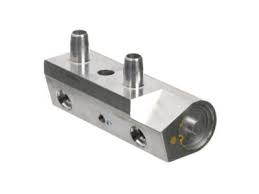
Thermal Bypass Valve (TBV)
The valve may be located internally or externally of the transmission, we will focus on the latter. There are three possible locations of the valve:
- Bolted directly to the transmission case.
- Built into the cooler.
- In the cooler lines between the transmission and the cooler.
MS Paint representation of possible TBV locations.
During cold operation, the thermal plunger is closed and allows the fluid to bypass the cooler until it reaches the operating temperature.
The thermal plunger opens between 120°F to 190°F depending on how the manufacturer designed it. This allows fluid to travel through the cooler before returning to the transmission.
GM Technical Service Bulletin 21-NA-199
Due to driveability, and longevity conditions on certain transmissions, GM changed the temperature that the thermal bypass opens from 194°F to 158°F
Conditions:
- Check engine light. Diagnostic trouble codes.
- Harsh shifts.
- Delayed shifts.
- Noises.
- Slipping.
- Shudder.
- Vibrations.
If your TBV is stamped with “70” on the end of the housing, then you have the updated valve. Your transmission temperature should operate around 158°F.
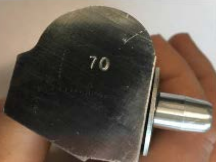
Thermal Bypass Valve (TBV)
In general, transmission operating temperatures should not exceed 200 degrees for prolonged periods. ATF degrades exponentially above this temperature and internal transmission damage will occur.
On most transmissions, it is required to replace the Cooler and TBV when replacing your transmission. Flushing Methods are only recommended on the cooler lines while they are disconnected from any components.
Replacement options.
- Best option – Replace the radiator, and if present the auxiliary cooler, and thermal bypass valve.
- Secondary option – Install an aftermarket standalone cooler and take the original cooling system offline (bypass it). Make sure the cooler is sized and placed correctly.
When selecting an aftermarket standalone cooler, it is recommended to use a cooler as big as possible in the space you have available, and make sure it can get a good supply of air flow at speed.
It also needs to be in a position that the cooling fans will draw air across it while idling in traffic.
Flushing.
Do not flush a Late Cooler Design (1990+) – REPLACE IT!
This cooler was flushed twice, in 45-minute intervals, in both directions, with proper cooler flushing equipment.
It also had normal flow observed on the flow meter during the flush process.
When looking closely you can see debris logged in the passages after flushing was complete.
Beware! Don’t flush with the following methods! Our technical support line has heard a lot of creative ways customers attempted to flush their cooler, these are not approved!
- NO - Can flush.
- NO - Garden hoses (water and oil don’t mix).
- NO - Electric pumps circulating ATF .
- NO - Compressed shop air (no amount will clean your cooler).
- NO - Fluid exchange machines
- This equipment is designed to maintain the transmission fluid at the manufacturer’s specified intervals, like an engine oil change.
- It uses the transmission pump to circulate fluid during the maintenance process.
Note If you use a fluid exchange machine to clean your transmission cooling system, you will pump contaminants into the new transmission before the machine has a chance to remove any debris.
Cooling systems in older vehicles with an Early Cooler Design can be flushed with dedicated transmission cooler flushing machines that can do the following.
- Heat the fluid to a minimum sustained temperature of 140°F.
- Pulsate the fluid pressure.
- Measure flow rate of fluid. (Very important).
Summary.
It is best to look at your transmission cooling system like you would an A/C system. Just like the A/C compressor will fail and contaminate the entire system, a failed transmission will contaminate the transmission cooling system.
You didn’t cause the original transmission to fail, however, you need to make sure the contaminants of that failure don’t cause a repeat failure. Ultimately it is the vehicle owner’s decision what will and won’t be replaced, but it is our job as educated and experienced auto technicians to advise the customer on the proper servicing techniques.
It is easier to explain the requirements of additional hardware needed when quoting the job to the customer, rather than during the job.
With this knowledge we hope it helps you accurately install your replacement transmission and keep you from having a comeback.